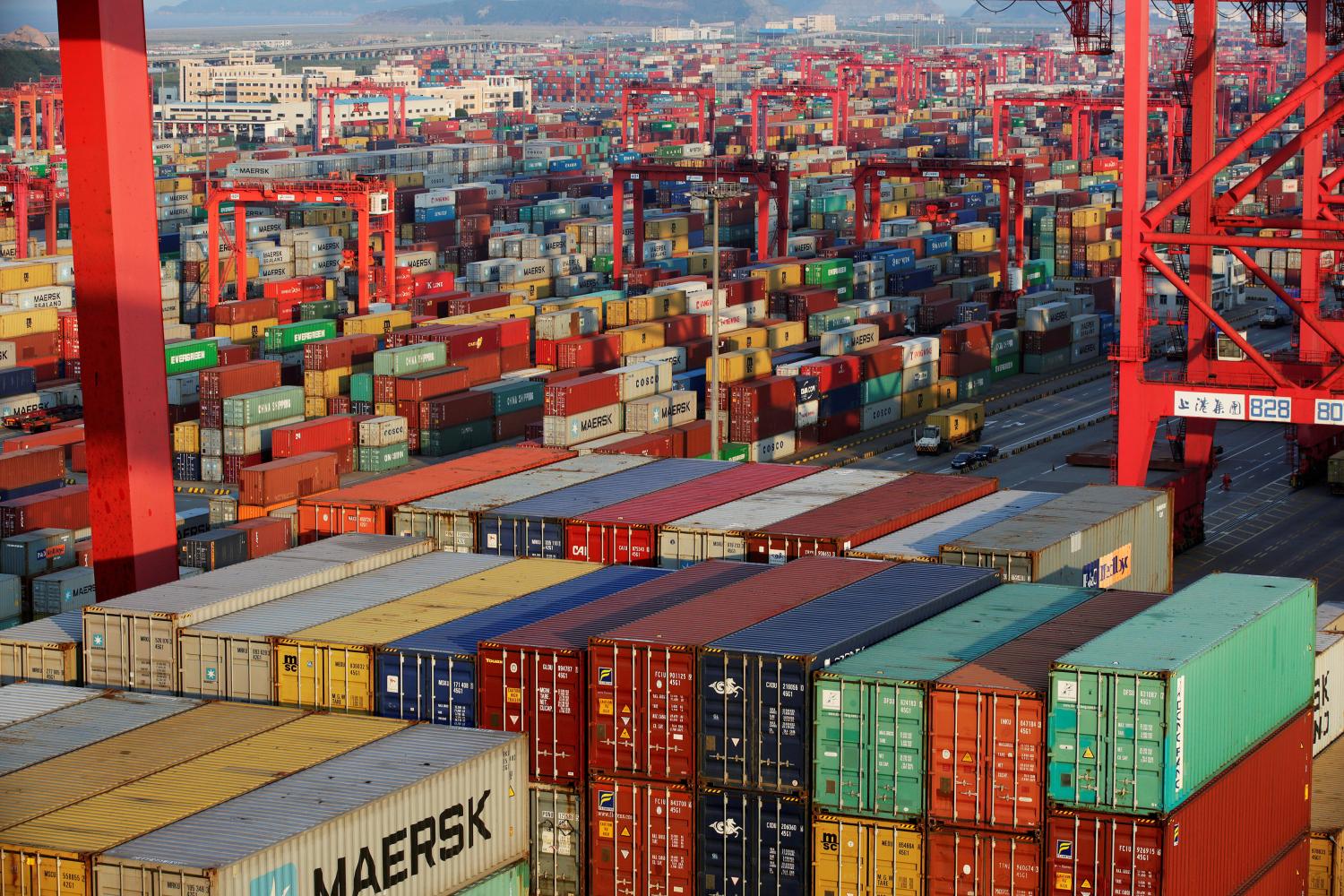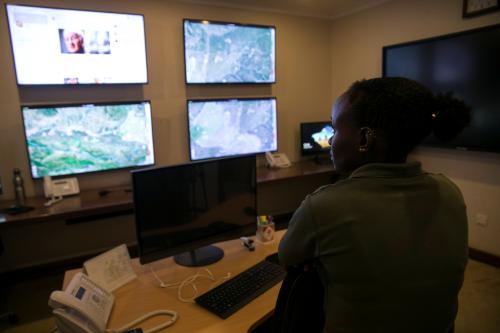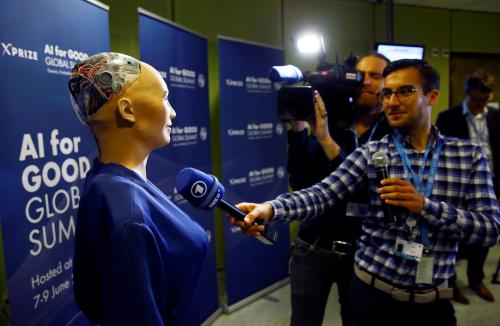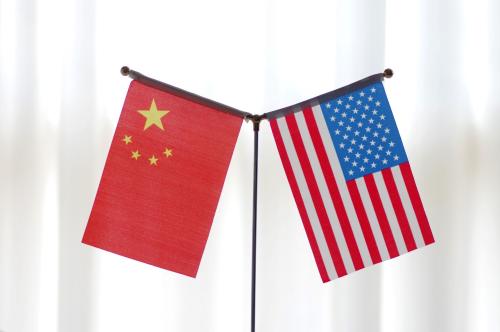This report is part of “A Blueprint for the Future of AI,” a series from the Brookings Institution that analyzes the new challenges and potential policy solutions introduced by artificial intelligence and other emerging technologies.
Artificial intelligence (AI) stands to have a transformative impact on international trade. Already, specific applications in areas such as data analytics and translation services are reducing barriers to trade. At the same time, there are challenges in the development of AI that international trade rules could address, such as improving global access to data to train AI systems. The following provides an overview of some of the key AI opportunities for trade as well as those areas where trade rules can help support AI development.
What do we mean by artificial intelligence?
Before proceeding to the impact of AI on trade, it is important to clarify what is meant by AI. More specifically, that there is a key difference between narrow AI such as translation services, chatbots, and autonomous vehicles and general AI—“self-learning systems that can learn from experience with humanlike breadth and surpass human performance on all tasks.” General AI raises broader existential concerns, such as how to align the goals of such a system with our own to prevent catastrophic outcomes,1 but general AI remains a technology still to be developed in the distant future.
To understand the potential significance of narrow AI for trade, it is also important to briefly consider its core parts. In particular, narrow AI is based on machine learning, which uses large amounts of data and powerful algorithms to develop increasingly robust predictions about the future.2 The data used for machine learning can be either supervised—data with associated facts, such as labels—or unsupervised—raw data that requires the identification of patterns without prior prompting.3 This includes reinforcement learning—where machine-learning algorithms actively choose and even generate their own training data.
Another key development underpinning narrow AI is the Deep Neural Network (DNN). DNNs are comprised of layers of nonlinear transformation node functions, where the output of each layer becomes an input to the next layer in the network. Each layer is highly modular, making it possible to take a layer optimized for one type of data (say, images) and to combine it with other layers for other types of data (e.g., text).4 Deep Neural Networks combine multiple machine learning tasks—creating what is referred to as general purpose machine learning (GPML)—which allows AI to effectively live on top of the types of chaotic data that humans are able to digest, such as video, audio, and text.
Narrow AI also includes specific tools such as out-of-sample validation to validate models, stochastic gradient descent for training models on streams of data, and graphical processing units (GPUs)—originally developed for video games but which have proven well-suited to support the types of massive parallel computations needed to train DNNs.5
Applying these developments in a real-world context requires large data sets to initialize AI systems. Here, quantity matters because machine learning needs to be able to incorporate into future predictions as many possible past outcomes as possible. This means that access to the tails of data—less usual and irregular data—matters.
The impact of AI on economic growth and international trade
The development of AI will affect international trade in a number of ways. One is the macroeconomic impacts of AI and the related trade effects. For instance, should AI increase productivity growth, then this will increase economic growth and provide new opportunities for international trade. Current rates of productivity growth globally are low and there are various suggested causes.6 One reason for low productivity growth particularly relevant for understanding the potential link with AI is that it takes time for an economy to incorporate and make effective use of new technologies, particularly complex ones with economy-wide impacts such as AI.7 This includes time to build a large enough capital stock to have an aggregate effect and for the complimentary investments needed to take full advantage of AI investments, including access to skilled people and business practices.8
AI will also affect the type and quality of economic growth, with international trade implications. For instance, AI is likely to accelerate the transition towards services economies.
AI will also affect the type and quality of economic growth, with international trade implications. For instance, AI is likely to accelerate the transition towards services economies. This is a corollary to concerns about the impact of AI and jobs, as AI is likely to expand automation and speed up job losses for low-skill, blue-collar workers in manufacturing fields.9 In parallel, AI will also emphasize particular worker skills as it is used to add value to production and products. This should lead to further expansion of the share of services in production as well as international trade.
Specific AI applications to international trade
AI and global value chains
AI is already having an impact on the development and management of global value chains. It can be used to improve predictions of future trends, such as changes in consumer demand, and to better manage risk along the supply chain. By allowing business to better manage complex and dispersed production units, such tools improve the overall efficiency of GVCs. For example, business can use AI to improve warehouse management, demand prediction, and improve the accuracy of just-in-time manufacturing and delivery. Robotics can increase productivity and efficiency in packing and inventory inspection. Business can also use AI to improve physical inspection and maintenance of assets along supply chains.
The development of GVCs will be affected by the broader trends toward using AI to develop smart manufacturing. For instance, the German-led conception of industry 4.0 is based on sensors, IoT, and cyber-physical-systems that connect machines, material, supplies, and customers. This will include capacity at the factory level of predictive machines and self-maintenance, complete communications between companies along the supply chain, and the ability to manufacture according to customer specifications, even in small or single batches.10 Such developments could strengthen and extend GVCs. For example, smart manufacturing with its emphasis on connectivity could open up GVCs to more specific participation by specialized service suppliers in areas such as R&D, design, robotics, and data analytics tailored to discrete tasks in the supply chain.
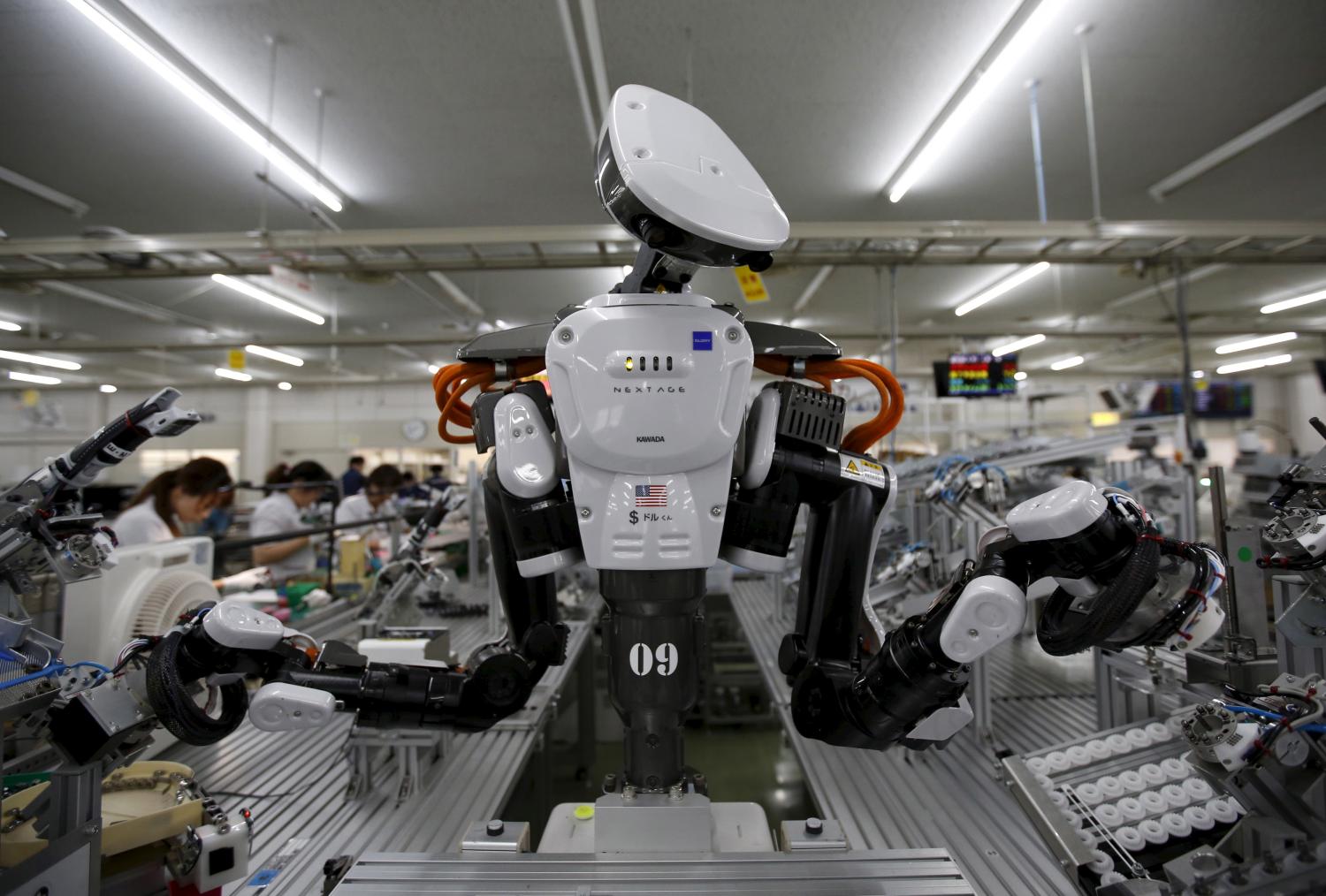
Yet AI could also create trends toward on-shoring of production. Broader automation opportunities as well as scaling of 3D printing could reduce the need for extended supply chains—particularly those that rely on large pools of low-cost labor. The result could accelerate the process Dani Rodrik describes as “premature industrialization” in developing countries.11
Trade using digital platforms
Another area where AI is already being deployed is on digital platforms such as eBay. For small business in particular, digital platforms have provided unprecedented opportunity to go global. In the U.S., for instance, 97 percent of small businesses on eBay export, compared to just 4 percent of offline peers.12
For small business in particular, digital platforms have provided unprecedented opportunity to go global.
AI-developed translation services are further enabling digital platforms as drivers of international trade. For example, as a result of eBay’s machine translation service, eBay-based exports to Spanish-speaking Latin America increased by 17.5 percent (value increased by 13.1 percent).13 To put this growth into context, a 10 percent reduction in distance between countries is correlated with increased trade revenue of 3.51 percent—so a 13.1 percent increase in revenue from eBay’s machine translation is equivalent to reducing the distance between countries by over 35 percent.
Trade negotiations
AI also has the potential to be used to improve outcomes from international trade negotiations. For instance, AI could be used to better analyze economic trajectories of each negotiating partner under different assumptions, including outcomes contingent on trade negotiation (growth pathways under various forms of trade liberalization), how these outcomes are affected in a multiplayer scenario where trade barriers are adjusted down at different rates, as well as predicting the trade response from countries not party to the negotiation. Brazil has already established an Intelligent Tech & Trade Initiative that includes using AI to improve trade negotiations.14
Developing trade rules to support AI
In addition to the impact of AI on international trade patterns, trade rules as reflected in the WTO and in FTAs can also play a role in supporting the development of AI. The following outlines some key areas where trade rules will matter for AI development and deployment globally.
The importance of data for AI
Data localization measures that restrict the ability to move data globally will reduce the capacity to develop tailored AI capacities.
Trade commitments on the free flow of data globally, as reflected in the Comprehensive and Progressive Agreement for Trans-Pacific Partnership (CPTPP) and, more recently, in the United States-Mexico-Canada Agreement (USMCA) will support the development of AI. As outlined above, access to large amounts of data is needed to train AI systems. Building AI systems that can respond to diverse challenges and different population groups requires access to global data. To take a relatively straightforward example, the development of speech-recognition AI requires access to large amounts of speech data that can capture local slang and intonation as well as less commonly used words. As a result, data localization measures that restrict the ability to move data globally will reduce the capacity to develop tailored AI capacities.
Moreover, the development and use of AI builds on other digital technologies, the key ones being cloud computing, big data, and the internet-of-things.15 These digital technologies also rely on cross-border data flows. This means that data localization measures that restrict global data transfers will hit AI directly, by providing less training data, and indirectly, by undercutting the building blocks on which AI is built.
Restrictions on cross-border data flows are likely to have the greatest impact on smaller (often developing) countries. The U.S. and China, with large internal populations, are less reliant on access to data from third countries to develop AI capabilities tailored to their domestic markets. However, to develop AI in areas such as health care, countries with smaller populations will require access to global health data. Limits on access to such data will reduce the accuracy and relevance of AI systems for developing countries.
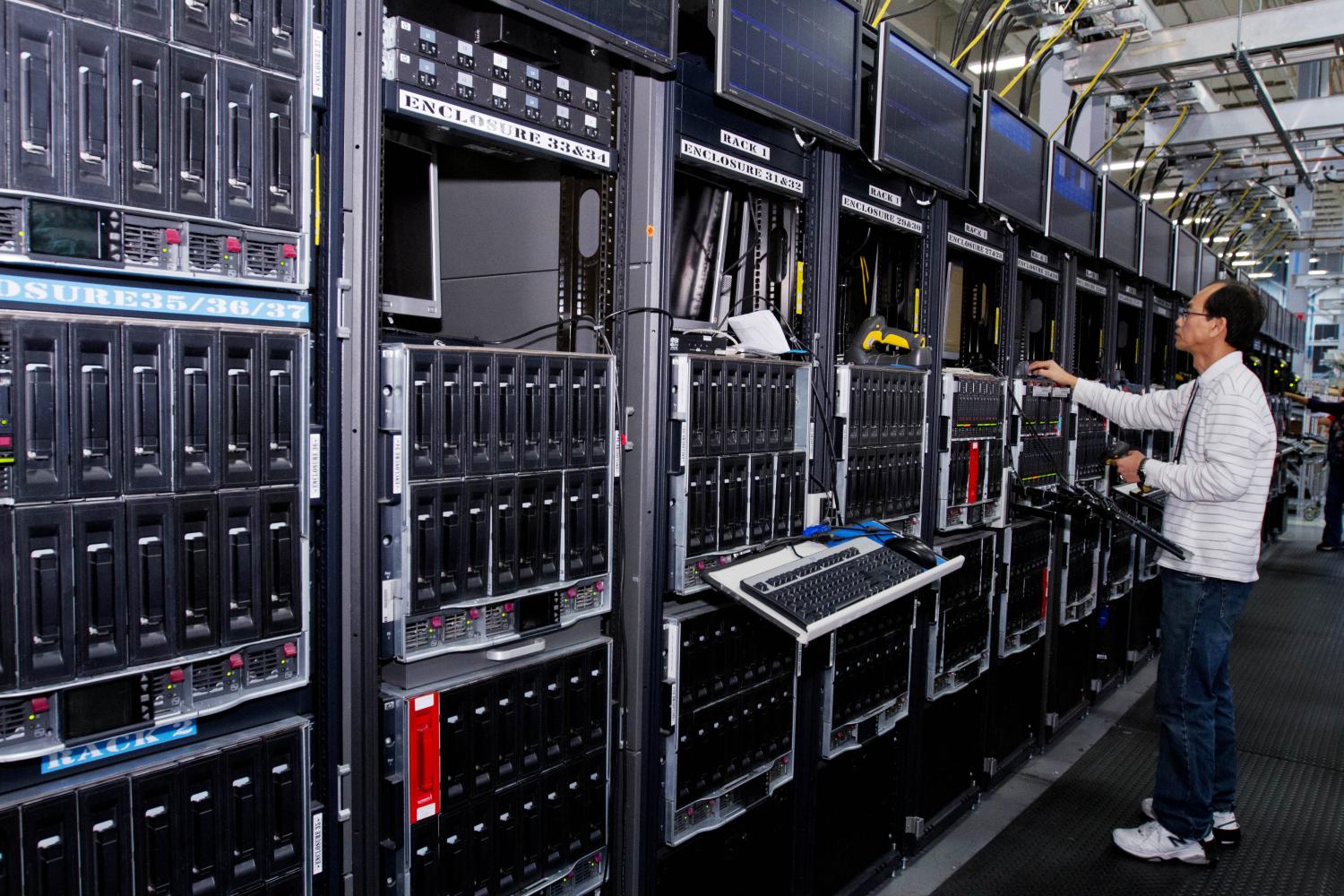
Improving access to data for AI development will also require governments, as repositories of large data sets, making such data publicly available. Here, USMCA makes progress, including a recognition by the Parties of the importance of access to government information for economic and social development, and to the extent possible making government data accessible in machine-readable and open format.16
Privacy and AI
Commitments to cross-border data flows in trade agreements are balanced with scope for governments to restrict data flows in order to achieve legitimate public policy objectives. Maintaining domestic privacy standards is a key reason that governments are currently reducing the flow of personal data across borders. For instance, the EU General Data Protection Regulation (GDPR) prohibits transfers of personal data to countries that have not been deemed “adequate” by the European Commission.
GDPR limits on the processing and use of personal data could adversely impact the development of AI capabilities. For instance, under GDPR, personal data can only be used for the purpose for which it was collected, which means that personal data collected as part of a transaction cannot then be used to train AI to improve how the service is delivered. The GDPR requirement that companies minimize the amount of data they collect and how long the data is kept is also at odds with developing data sets for training AI.
GDPR limits on the processing and use of personal data could adversely impact the development of AI capabilities.
On the other hand, strong privacy will be required if people are going to be able to trust living their lives online, including providing immense amounts of personal data for AI learning. From this perspective, there is no inherent trade-off between developing AI and privacy. The key challenge will be to design privacy rules that do not create unnecessary restrictions on access to and use of data. Trade rules can assist by including commitments on data-importing nations to protect the privacy of personal data from the data-exporting country. This could be achieved by encouraging forms of mutual recognition of privacy systems as well as developing common regional and global privacy principles.17
Standards and AI
The incorporation of AI into industry will require the development of a range of new standards. Take autonomous vehicles, which will require various technical standards, safety standards, and new vehicle manufacturing standards. The development of different domestic standards across countries will increase costs for foreign manufacturers who have to retool in order to export. The USMCA addresses this issue with commitments that domestic standards are based on international standards, which will support interoperability and reduce barriers to developing AI globally.
Protection of source code
Requiring access to source code as a condition of investment or market access poses another challenge to the development of AI. Requiring such access was identified by the Office of the United States Trade Representative (USTR) as part of the broader issue of forced technology transfer in China.18 As AI is based on algorithms, conditioning market access on providing access to source code operates as an international trade barrier that reduces the diffusion of AI globally.
The U.S. and other countries have started to respond to this concern. In the CPTPP and USMCA, the parties have agreed not to “require the transfer of, or access to, source code of software owned by a Person of another party” as a condition for import or sale.19
Intellectual property protection and AI
The development of AI raises intellectual property (IP) issues with international trade implications. As noted, AI relies on large amounts of input data. Training data will often need to be copied and edited for use. Depending on how the data is collected, this could involve unauthorized copying of thousands of protected works. In the U.S., it may be that relying on the “transformative” or “non-expressive” fair use exception to copyright protection will provide legal cover for such use of data.20 Fair use provides a flexible principles-based set of copyright exceptions.21 Fair use exceptions have been a significant legal underpinning in the development, and demise, of digital business models in the U.S.22 Yet, even in the U.S., whether fair use exceptions will cover some of the more complex uses of data to train AI remains to be tested.23
Even in the U.S., whether fair use exceptions will cover some of the more complex uses of data to train AI remains to be tested.
Furthermore, fair use exceptions or similar copyright flexibilities do not exist in many other countries. For instance, the EU uses a specific list of exceptions to copyright law that does not include text and data mining and would not seem to include AI. Australia adopts a similar approach as the EU.24 From an international trade perspective, this means that legal copying of data to develop AI in the U.S. might be deemed illegal in other countries, creating a barrier to deployment of AI in these countries.
Trade agreements have been hesitant in addressing copyright flexibilities. The CPTPP includes a recognition by the Parties of the need to achieve “an appropriate balance in its copyright and related rights systems,”25 but this goal of achieving a copyright balance was absent from the more recent USMCA.
AI and trade in goods
While much of AI development is focused around access to data, standards, and IP, access to goods will also affect AI development globally. In particular, and as noted above, CPUs are a key hardware used in Deep Neural Networks. Trade in CPUs is therefore needed for the development of AI globally. This underscores the ongoing role for reducing tariffs in supporting access to the technologies needed for AI development.
The report’s author, Joshua Meltzer, gratefully acknowledges support he is receiving from the Hinrich Foundation for a related Digital Economy and Trade Project.
Brookings recognizes that the value it provides is in its absolute commitment to quality, independence, and impact. Activities supported by its donors reflect this commitment.
-
Footnotes
- See generally https://futureoflife.org/background/benefits-risks-of-artificial-intelligence/, visited 26 November 2018.
- Stuart Russell, Daniel Dewey and Max Tegmark, “Research Priorities for Robust and Beneficial Artificial Intelligence”, AI Magazine, Winger 2015, p. 106.
- Kevin P. Murphy, “Machine Learning: A probabilistic Perspective” (2007), 1-2.
- Matt Taddy, The Technological Elements of Artificial Intelligence, NBER Working Paper 24301, February 2018.
- Ibid.
- Remes Jaana. et al, “Solving the productivity puzzle: the role of demand and the promise of digitization”, McKinsey Global Institute, February 2018; Byrne, David M, J.G. Fernald and M.B. Reinsdorf. 2016. “Does the United States Have a Productivity Slowdown or a Measurement Problem?” Brookings Papers on Economic Activity, (Spring) 109.
- Erik Brynjolfsson et al., “Artificial Intelligence and the Modern Productivity Paradox: A Clash of Expectations and Statistics”, NBER Working Paper no. 24001, October 2017 (revised December 2017), p. 10.
- Ibid.
- Arnet, Melanie, Terry Gregory and Ulrich Zierahn. 2016. “The Risk of Automation for Jobs in OECD Countries: A Comparative Analysis.” OECD Social, Employment and Migration Working Papers No.189.
- Qin J, Ying, Liu and Roger Grosvenor, “A Categorical Framework of Manufacturing for Industry 4.0 and Beyond”, Procedia CIRP 52 (2016) 174.
- Dani Rodrick 2015. “Premature Industrialization”, NBER Working Paper 20935, February 2015.
- Ebay 2015. “Empowering People and Creating Opportunity in the Digital Single Market” An eBay report on Europe’s potential, October 2015.
- Brynjolfsson, E, X Hui and Meng Liu (2018), “Does Machine Translation Affect International Trade? Evidence from a Large Digital Platform”.
- http://itti-global.org.
- McKinsey Global Institute, “The Promise and Challenge of the Age of Aritificial Intelligence”, October 2018, https://www.mckinsey.com/~/media/McKinsey/Featured%20Insights/Artificial%20Intelligence/The%20promise%20and%20challenge%20of%20the%20age%20of%20artificial%20intelligence/MGI-The-promise-and-challenge-of-the-age-of-artificial-intelligence-in-brief-Oct-2018.ashx (visited November 19th, 2018)
- USMCA Article 19.18.
- Aaditya Mattoo and Joshua P. Meltzer 2018, “International Data Flows and Privacy: the conflict and its resolution”, Journal of International Economic Law
- Office of the USTR, Finding of the Investigation into China’s Acts, Policies, And Practices related to Technology Transfer, Intellectual Property, And Innovation Under Section 301 of the Trade Act 1974, March 22, 2018.
- USMCA article 19.16.
- Authors Guild v. Google Inc., 804 F.3d 202 (2nd Cir. 2015).
- https://fairuse.stanford.edu/overview/fair-use/what-is-fair-use/.
- See Perfect 10 Inc. v. Amazon. Com, Inc., 508 F. 3d 1146 (9th Cir. 2007), allowing fair use to excuse an image search engine’s unauthorized reproductions of copyrights photographs; and Capitol Records, LLC v. ReDIGIT Inc., 934 F.Supp.2d (S.D.N.Y. 2013) which found that fair use does not excuse a second hand market place for digital sound recordings from liability for infringement.
- Benjamin Sobel 2017. “Artificial Intelligence’s Fair Use Crisis”, Columbia Journal of Law & the Arts 45 (2017), p. 68-71.
- Joshua P. Meltzer, “ Digital Australia: An Economic and Trade Agenda”, Brookings Working Paper 118, May 2018.
- CPTPP 2018, Art 18.66.
The Brookings Institution is committed to quality, independence, and impact.
We are supported by a diverse array of funders. In line with our values and policies, each Brookings publication represents the sole views of its author(s).

